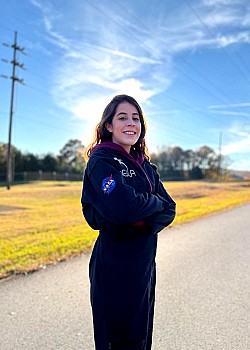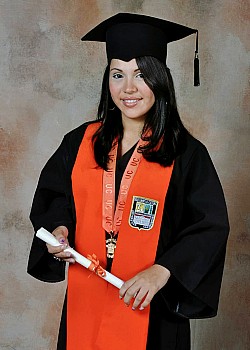About Raquel Reyes
Even before entering Huawei's 'Semillas del Futuro' (Seeds for the Future) project, Raquel Reyes, an innovation and development engineer from the Tecnológico de Monterrey, already had a restless mind.
In November 2020 she founded her blog Disrupción de ella, in which she publishes scientific dissemination content, which she complements with informative capsules on an Instagram account of the same name. In these short videos, Reyes talks about both the butterfly nebula, topics of Artificial Intelligence, and the Turing test.
"I share what I am passionate about in the hope of inspiring someone like you," says Reyes in an entry on her blog, just as Katya Echazarreta, the first Mexican woman to travel to space, attempts.
"I am passionate about museums and putting myself in challenging situations," she adds.
That same impulse led her to work to be one of the 60 people selected to participate in NASA's International Air and Space Program.
Reyes had an outstanding participation in the program. Her team won a competition by offering the mechanism for lunar exploration with the flexible features desired by researchers at NASA's Space and Rocket Center.
As a prize, the prototype of this mechanism will be launched into the Materials International Space Station Experiment module (MISSE) and will stay there for six months.
Raquel embarked on a new adventure in 2021, when she entered Huawei's Semillas del Futuro, an initiative that seeks to encourage local talent through the support and implementation of ideas and projects for innovative technological solutions with social impact.
"This is a program that has already been carried out in more than 137 countries. In Mexico it arrived in 2015 and until December of last year we had 130 students who participated. It is a training program that has evolved over the years," said Shau Wa, public relations manager of Huawei Mexico.
Initially, students who were part of the program traveled to China for 2 weeks. During their stay they had seven days of cultural immersion in Beijing, and received classes in Mandarin, calligraphy, painting and visited the Forbidden City as well as the Chinese Wall.
In the second week, in Shenyang, where Huawei's headquarters is located, students had classes in laboratories, outreach and exclusive visits to the company's showrooms.
However, due to the pandemic, it was necessary to resort to the distance modality, in which up to 40 students participated and learned from experts in the field of technology.
In one of these events, Reyes shone again by winning, together with his team, the 2021 edition, with the development of an app that used Machine Learning and data analysis to help reduce food waste within medium and medium-sized restaurants. large size in Mexico City.
"We were the winning team in the Mexico class and from there we had to make the prototype," she said.
Reyes expressed that although the project has not come to fruition, her experience allowed her to mix diverse knowledge that enriched her professional profile.
"It helped me a lot for the implementation of new projects, because many times within the degree we stay with the concepts, so this did help me a lot to say, but what if we included part of the cybersecurity or what if we added Machine Learning?" he said.

















